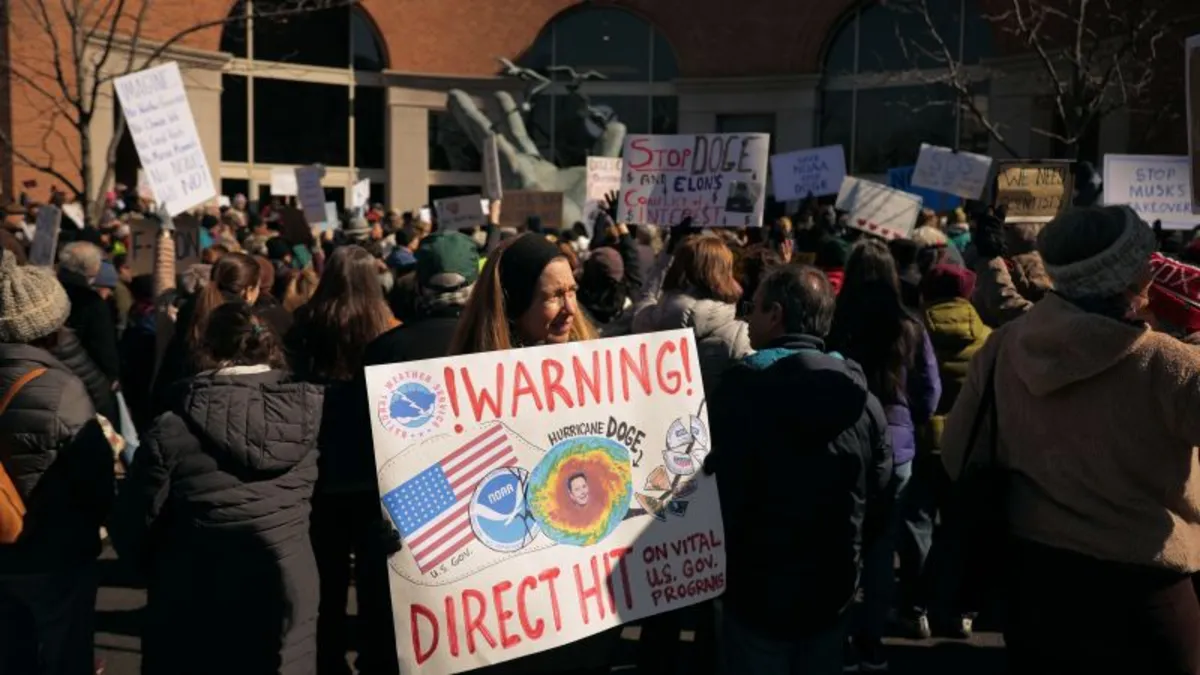
The Trump administration’s federal cuts and increasing feelings of economic uncertainty have significantly contributed to a sharp rise in layoffs last month, as revealed by new data released on Thursday. US-based employers announced plans to cut a staggering 172,017 jobs in February, marking a remarkable 103% increase from January. This total is the highest recorded for February since 2009, according to the latest monthly job cuts report from Challenger, Gray & Christmas.
This figure stands as the 12th highest monthly total in the 32-year history of Challenger’s tracking of job cuts. Notably, 11 of the previous high totals occurred during periods of recession, with four happening during the Covid-19 pandemic. The report highlights a concerning trend in job cuts that could indicate a downturn in the economy.
The largest share of job cuts was seen in the government sector, where the newly formed Department of Government Efficiency has made significant reductions. This department has not only axed jobs but has also slashed federal spending and canceled contracts, leading to 62,242 announced cuts across 17 federal agencies. This represents a staggering 41,311% increase from the mere 151 cuts announced in February 2024.
Moreover, the impact of these government actions extended beyond the public sector, resulting in additional layoffs in private nonprofits, totaling 894 cuts. Other sectors experiencing notable job losses include retail (38,956 cuts), technology (14,554 cuts), and consumer products (10,625 cuts). Reasons behind these job cuts vary, with the primary drivers being actions from the Department of Government Efficiency (DOGE) leading to 63,583 job cuts, followed by bankruptcy (35,172), unfavorable market conditions (28,098), and restructuring efforts (16,828).
Andrew Challenger, senior vice president at Challenger, Gray & Christmas, emphasized the factors contributing to the spike in job cuts. He stated, “With the impact of the Department of Government Efficiency actions, as well as canceled government contracts, fear of trade wars, and bankruptcies, job cuts soared in February.” However, the report also noted a glimmer of hope: companies’ hiring plans surged to 34,580 in February, the highest for that month since 2022.
The Challenger report serves as an essential indicator of the economic landscape, particularly regarding the federal workforce cuts and their potential effects. Economists are closely monitoring the weekly unemployment claims as a vital sign of the labor market's health. Recent data from payroll giant ADP shows a concerning trend; hiring activity in the US private sector dropped significantly in February, with an estimated increase of only 77,000 jobs. This figure contrasts sharply with January's strong job growth of 186,000 and falls short of the 142,500 net gain that economists had anticipated.
Industries heavily reliant on consumer activity, particularly service-based sectors, witnessed some of the most significant employment declines. Nela Richardson, chief economist at ADP, remarked, “We can’t lose sight of the biggest driver of the economy, which is consumers.” A recent report from the Commerce Department indicated that consumer spending fell in January for the first time in nearly two years, raising concerns about potential economic slowdowns.
The Bureau of Labor Statistics (BLS) is set to release the February jobs report on Friday at 8:30 a.m. ET. Economists widely expect another month of solid job gains, with consensus estimates predicting a net increase of 160,000 jobs and the unemployment rate remaining at a low 4%. If these forecasts prove accurate, February's job gains would surpass January’s disappointing total of 143,000 jobs, which some experts attribute to seasonal factors, severe weather, and the impact of wildfires in Los Angeles.
However, the effects of DOGE-driven employment cuts may not be immediately visible in the February jobs report due to timing issues. Many layoffs occurred after the survey period (the week of the 12th), and those receiving pay for any part of that pay period are counted as employed. Additionally, some federal workers are on paid notice periods, delaying their transition to unemployment. Economists suggest that the full impact of federal job cuts will likely manifest in the March and April jobs reports.
Despite recent economic upheavals, job growth has generally remained stable enough to bolster consumer spending and guide the economy towards a "soft landing"—a scenario where inflation is curbed without triggering a recession. Claudia Sham, chief economist at New Century Advisors, noted, “The February jobs report could be a snapshot of where the labor market was before things started really moving.”
Economists have noted that the labor market has shown resilience, with low unemployment rates and solid job growth, but there are emerging concerns about the slowdown in hiring and increased uncertainty due to political and economic factors. The potential negative impacts of government spending cuts and tariffs are causing businesses to adopt a more cautious approach, leading to what Martha Gimbel, economist and executive director at the Budget Lab at Yale University, describes as a “batten-down-the-hatches mentality.”
As the economic situation continues to evolve, all eyes remain on the upcoming jobs report and subsequent data releases, as they may provide crucial insights into the future of the labor market and overall economic health.